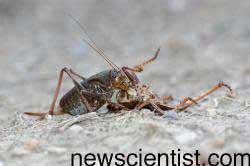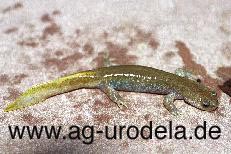Cannibalism
Biology 342 Fall 06
Competitive Cannibalism
Cannibalism
is prevalent in situations of limited resources. These resources
can be food, mates, shelter, etc. In order to obtain resources for
themselves, some animals resort to cannibalism to reduce competition.
One such example of this competitive cannibalism exists in larval tiger salamanders (Ambystoma tigrinum). There are two morphs of tiger salamanders, one that is a typical morph
that feeds on invertebrates and a cannibal morph that preys on
conspecifics on a regular basis. Studies show that the cannibalistic
morph is induced by stimuation from other larval tiger salamanders
or from starvation. This morph can be reversed if conditions change
within a certain critical period. The stimulation from other larvae
must be tactile, chemical, and visual in order for the morph to be
cannibalistic. In a crowded situation, in which all of these cues from
other larvae are present, the larvae will become cannibalistic and eat
their conspecifics. Identical results can be obtained with
heterospecifics as well, which were A. texanum in this study. Once one cannibal morph is present, the likelihood that other cannibals will form is significantly increased.
is a typical morph
that feeds on invertebrates and a cannibal morph that preys on
conspecifics on a regular basis. Studies show that the cannibalistic
morph is induced by stimuation from other larval tiger salamanders
or from starvation. This morph can be reversed if conditions change
within a certain critical period. The stimulation from other larvae
must be tactile, chemical, and visual in order for the morph to be
cannibalistic. In a crowded situation, in which all of these cues from
other larvae are present, the larvae will become cannibalistic and eat
their conspecifics. Identical results can be obtained with
heterospecifics as well, which were A. texanum in this study. Once one cannibal morph is present, the likelihood that other cannibals will form is significantly increased.
This study, however, does not provide evidence about the specific fitness advantages. The larvae could be reducing competition by eating competitors, or they could be responding to crowding and thus limited resources by eating larvae around it because food resources are strained.
(Hoffman and Pfennig 1999)
Another example of competitive cannibalism more directly linked to lack o f food resources comes from a study of Mormon crickets. Millions of Mormon crickets can be found in migratory
bands that can extend up to 10 km in length. Cannibalism is prevalent
in these migratory bands and a study by Simpson et al. points to
the lack of resources as the trigger (2006). When so many
crickets are present in one situation, resources become greatly
limited. Many of these crickets resort to eating conspecifics. The most
limiting resources are protein and salt, and within these bands the
crickets themselves are the major source of nutrients in the field.
They eat wounded, molting, and freshly dead insects, but also
participate in active predation. During active predation the prey
cricket tries to defend itself by kicking with the hind legs, thus
wounded or immobile crickets are at greater risk. Protein consumption
also inhibits locomotion, so crickets that have just consumed protein are
moderately immobile and also at a greater risk.
f food resources comes from a study of Mormon crickets. Millions of Mormon crickets can be found in migratory
bands that can extend up to 10 km in length. Cannibalism is prevalent
in these migratory bands and a study by Simpson et al. points to
the lack of resources as the trigger (2006). When so many
crickets are present in one situation, resources become greatly
limited. Many of these crickets resort to eating conspecifics. The most
limiting resources are protein and salt, and within these bands the
crickets themselves are the major source of nutrients in the field.
They eat wounded, molting, and freshly dead insects, but also
participate in active predation. During active predation the prey
cricket tries to defend itself by kicking with the hind legs, thus
wounded or immobile crickets are at greater risk. Protein consumption
also inhibits locomotion, so crickets that have just consumed protein are
moderately immobile and also at a greater risk.
One such example of this competitive cannibalism exists in larval tiger salamanders (Ambystoma tigrinum). There are two morphs of tiger salamanders, one that
 is a typical morph
that feeds on invertebrates and a cannibal morph that preys on
conspecifics on a regular basis. Studies show that the cannibalistic
morph is induced by stimuation from other larval tiger salamanders
or from starvation. This morph can be reversed if conditions change
within a certain critical period. The stimulation from other larvae
must be tactile, chemical, and visual in order for the morph to be
cannibalistic. In a crowded situation, in which all of these cues from
other larvae are present, the larvae will become cannibalistic and eat
their conspecifics. Identical results can be obtained with
heterospecifics as well, which were A. texanum in this study. Once one cannibal morph is present, the likelihood that other cannibals will form is significantly increased.
is a typical morph
that feeds on invertebrates and a cannibal morph that preys on
conspecifics on a regular basis. Studies show that the cannibalistic
morph is induced by stimuation from other larval tiger salamanders
or from starvation. This morph can be reversed if conditions change
within a certain critical period. The stimulation from other larvae
must be tactile, chemical, and visual in order for the morph to be
cannibalistic. In a crowded situation, in which all of these cues from
other larvae are present, the larvae will become cannibalistic and eat
their conspecifics. Identical results can be obtained with
heterospecifics as well, which were A. texanum in this study. Once one cannibal morph is present, the likelihood that other cannibals will form is significantly increased. This study, however, does not provide evidence about the specific fitness advantages. The larvae could be reducing competition by eating competitors, or they could be responding to crowding and thus limited resources by eating larvae around it because food resources are strained.
(Hoffman and Pfennig 1999)
Another example of competitive cannibalism more directly linked to lack o
 f food resources comes from a study of Mormon crickets. Millions of Mormon crickets can be found in migratory
bands that can extend up to 10 km in length. Cannibalism is prevalent
in these migratory bands and a study by Simpson et al. points to
the lack of resources as the trigger (2006). When so many
crickets are present in one situation, resources become greatly
limited. Many of these crickets resort to eating conspecifics. The most
limiting resources are protein and salt, and within these bands the
crickets themselves are the major source of nutrients in the field.
They eat wounded, molting, and freshly dead insects, but also
participate in active predation. During active predation the prey
cricket tries to defend itself by kicking with the hind legs, thus
wounded or immobile crickets are at greater risk. Protein consumption
also inhibits locomotion, so crickets that have just consumed protein are
moderately immobile and also at a greater risk.
f food resources comes from a study of Mormon crickets. Millions of Mormon crickets can be found in migratory
bands that can extend up to 10 km in length. Cannibalism is prevalent
in these migratory bands and a study by Simpson et al. points to
the lack of resources as the trigger (2006). When so many
crickets are present in one situation, resources become greatly
limited. Many of these crickets resort to eating conspecifics. The most
limiting resources are protein and salt, and within these bands the
crickets themselves are the major source of nutrients in the field.
They eat wounded, molting, and freshly dead insects, but also
participate in active predation. During active predation the prey
cricket tries to defend itself by kicking with the hind legs, thus
wounded or immobile crickets are at greater risk. Protein consumption
also inhibits locomotion, so crickets that have just consumed protein are
moderately immobile and also at a greater risk.
Providing these crickets with constant access to protein and salt for five hours resulted in a significantly reduced amount of cannibalism. Thus the cannibalism is a means of gaining access to resources that the cricket is lacking. This activity greatly increases the cannibalistic cricket's fitness. Being within these migratory bands, even in the presence of cannibals, is better than leaving the group and exposing a sole cricket to heterospecific predation. These crickets have adapted to limited resources by finding the next best source: each other (Simpson et al. 2006).
Another such example of using conspecifics as a resource/removing competition occurs in the larvae of the pond-breeding salamander Hynobius nebulosus.
 These larvae have a high frequency of cannibalism based on a high
population density at the time of hatching. This results in a potential
food shortage if all of these larvae are to grow and develop in one
small pond. Older larvae can eat younger larvae because they have enlarged or modified mouth structures for
cannibalism. The older larvae attack the younger and smaller
larvae head first and swallow them whole (Kusano et al. 1985). Their fitness is increased by
reducing the number of competitors and also possibly from the nutrition
gained by the consumption of other larvae, although the paper by Kusano
et al does not discuss the fitness advantages explicitly.
These larvae have a high frequency of cannibalism based on a high
population density at the time of hatching. This results in a potential
food shortage if all of these larvae are to grow and develop in one
small pond. Older larvae can eat younger larvae because they have enlarged or modified mouth structures for
cannibalism. The older larvae attack the younger and smaller
larvae head first and swallow them whole (Kusano et al. 1985). Their fitness is increased by
reducing the number of competitors and also possibly from the nutrition
gained by the consumption of other larvae, although the paper by Kusano
et al does not discuss the fitness advantages explicitly. 